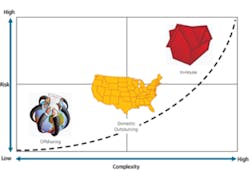Twenty years ago, test companies were just starting to transition from vertical integration to outsourcing. More recently, there has been a growing interest in outsourcing in terms of measuring the total benefit to customers. Yet, only the lowest-risk subassemblies currently are being outsourced to offshore locations, and although outsourcing domestically can mitigate the risks associated with outsourcing, its adoption in the market remains limited.
A key driver for domestic outsourcing is capacity. The economic downturn of the past two years certainly has fueled this driver as test companies reduced headcounts.
Over time, the growing capabilities of contract manufacturers also have played a major role in increasing the adoption of outsourcing in the market. Some subassemblies such as cable or PCB assemblies are simply more readily manufactured by third parties that have greater expertise in those arenas.
“Designing and manufacturing high-quality modular instrumentation and graphical system design software are our core competencies for test and measurement,” said Richard McDonell, senior group manager at National Instruments. “For us, this means growing core investments in R&D to drive the advancement of PXI, LabVIEW, and NI TestStand. We also strive to provide engineers with a complete offering of other system components and related accessories to help complete their automated test systems.”
Despite those drivers, outsourcing is far from being a primary business model for test companies. In essence, test products are used to test other products so they must be of high quality and reliability to ensure the performance of the products being tested.
Hiccups faced by some companies have not helped the adoption of outsourcing in the industry. Product quality and reliability remain the key concerns of test leaders.
Test and Measurement Market: Outsourcing Opportunity by Level of Risk and Complexity, 2010
Courtesy of Frost & Sullivan
According to Bernard Ressler, director of materials for Anritsu, “We have retained the ability to provide the final set of eyes to the instrument before it is shipped. This includes the final configuration, testing, and assembly as well as the assembly and test of all the high-frequency RF and microwave components.”
In the end, the key customer benefits of the hybrid approach are higher product quality since many test leaders outsource only when the capabilities of suppliers match or exceed theirs. The hybrid approach also fosters innovation because test companies are more focused on their core competencies. Finally, the customer pays less since test companies’ costs would be higher if they were completely vertically integrated.
However, the industry may have to do more outsourcing. The most recent downturn made it clear that the test industry is cyclical in nature. Participants must adjust their cost structures to address market volatility.
“Although the goal is to retain jobs in North America, outsourcing is an effective way for companies to better compete during a downturn. This capability ultimately results in saving jobs and the health of the company,” said Warren Kocmond, vice president of Global Operations for Verigy.
Moreover, globalization is perhaps the bigger trend now. As their customer bases shift to emerging countries, companies need production operations closer to their customers to reduce lead times and provide further support and service.
Soon-Chai Gooi, vice president and general manager, Worldwide Order Fulfillment, Electronic Measurement Group at Agilent Technologies, explained, “While Agilent leverages existing strategic partners that have established supply chains and the design capability to expand and achieve economies of scale for cost optimization, we also leverage the presence of those partners to extend our geographical reach and minimize logistics costs.”


